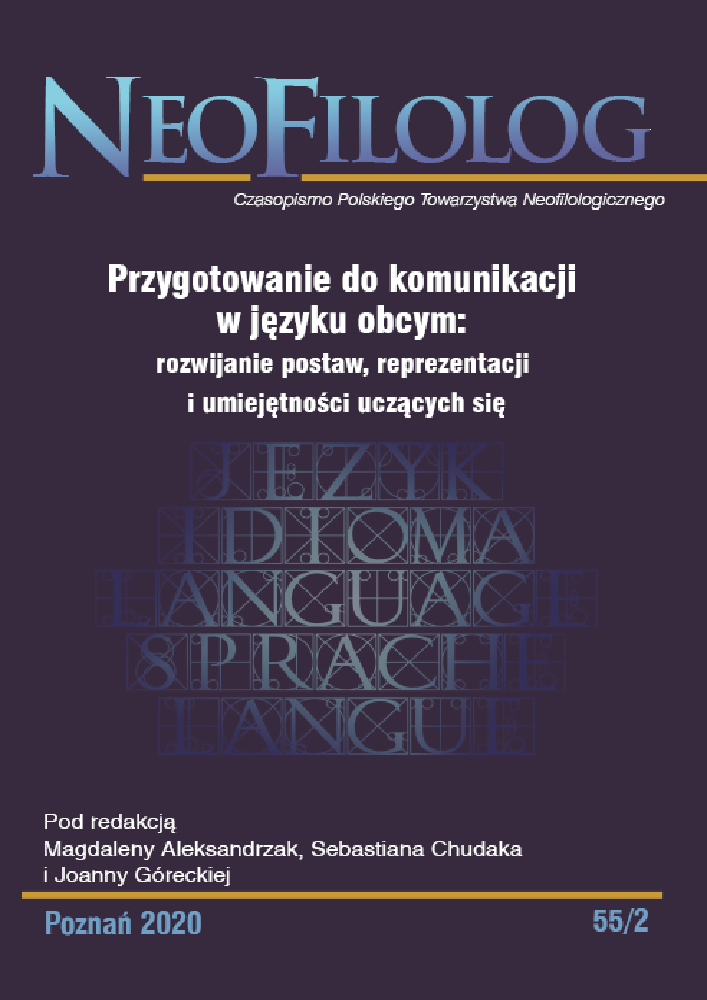Abstrakt
The article investigates the teaching of French as a third or additional language (De Angelis, 2007) at the beginning level to international students from different language backgrounds and their learning of that language, as perceived by the students themselves, as well as revealed by tests. Special attention is paid to the areas of difficulty perceived by the students, their perception of the similarities and differences between French and their native languages as well as between French and other languages they already know, especially English, and of the teaching strategies, which included cross-linguistic awareness-raising. Assessment of their progress in French is also considered. The study involves a combination of two methods: long-term classroom observation and assessment of 29 students, and a questionnaire filled out by 20 of those students. As the results show, the participants’ awareness of similarities and differences is fairly high, but their attitudes towards awareness-raising, feedback, etc. vary considerably. The tests are both formative and summative (but also providing feedback). However, the feedback was mutual: apart from giving feedback to the students, the author could also modify her teaching according to their problems and wishes concerning the French classes.
Bibliografia
Bachman L.F. (2014), Ongoing challenges in language assessment, (in:) Kunnan, A.J. (ed.), The companion to language assessment. Vol. III. Evaluation, methodology and interdisciplinary themes. Hoboken, NJ: John Wiley and Sons, pp. 1-18.
Bialystok E. (1985), The compatibility of teaching and learning strategies. “Applied Linguistics”, No 6(3), pp. 255-262.
Byram M. (2012), The Eric Hawkins lecture. Language awareness and (critical) cultural awareness – relationships, comparisons and contrasts. “Language Awareness”, No 21, pp. 5-13.
Capelle G., Menand, R. (2009), Le Nouveau Taxi! A1. Paris : Hachette.
De Angelis G. (2007), Third or additional language acquisition. Clevedon/Buffalo/Toronto: Multilingual Matters Ltd.
Edelenbos P., Kubanek-German A. (2004), Teacher assessment: the concept of ‘diagnostic competence’. “Language Testing”, No 21(3), pp. 259-283.
Gorter D., Cenoz J. (2017), Language education policy and multilingual assessment. “Language and Education”, No 31(3), pp. 231-248.
Grégoire M., with the participation of Merlo, G. (2010), Grammaire progressive du français. Niveau débutant. Paris: CLE International.
Herdina P., Jessner U. (2002), A dynamic model of multilingualism. Perspectives of change in psycholinguistics. Clevedon: Multilingual Matters Ltd.
Hill K., McNamara T. (2012), Developing a comprehensive, empirically-based research framework for classroom-based assessment. “Language Testing”, No 29(3), pp. 395-420.
Hufeisen B. (2018), Models of multilingual competence, (in:) Bonnet, A., Siemund, P. (eds.), Foreign language education in multilingual classrooms. Amsterdam/Philadelphia: John Benjamins Publishing Company, pp. 173-189.
Hugot C. et al. (2012), Alter Ego+, A1. Méthode de français. Paris: Hachette.
James C. (1996), A cross-linguistic approach to language awareness. “Language Awareness”, No 5, pp. 138-148.
Jessner U. (1999), Metalinguistic awareness in multilinguals: cognitive aspects of third language learning. “Language Awareness”, No 8, pp. 201-209.
Kellerman E. (1987), Aspects of Transferability in Second Language Acquisition. Nijmegen: Katholieke Universiteit Nijmegen.
Klein E.C. (1995), Second versus third language acquisition: Is there a difference? “Language Learning”, No 45(3), pp. 419-465.
Müller-Lancé J. (2003), Der Wortschatz romanischer Sprachen im Tertiärsprachenerwerb.Lernerstrategien am Beispiel des Spanischen, Italienischen und Katalanischen. Tübingen: Stauffenburg Verlag.
Rea-Dickins P. (2007), Classroom-based assessment: Possibilities and pitfalls, (in:) Cummins, J., Davidson, C. (eds.), International handbook of English language teaching. Boston, MA: Springer, pp. 505-520.
Singleton D. (2000), Language and the lexicon. An introduction. London: Arnold.
Velupillai V. (2012), An introduction to linguistic typology. Amsterdam/Philadelphia: John Benjamins Publishing Company.
Włosowicz T.M. (2009), Transfer and the construction of multilingual competence: the perception and use of similarities between Swedish, German and English by Polish learners of Swedish as L4. Paper presented at the 21st International Conference on Foreign/ Second Language Acquisition, Szczyrk, 28-30.05.2009.
Włosowicz T.M. (2016), Adult learners’ expectations concerning foreign language teachers and the teaching-learning process, (in:) Gabryś-Barker, D., Gałajda, D. (eds.), Positive Psychology Perspectives on Foreign Language Learning and Teaching. Springer International Publishing Switzerland, pp. 267-285.
Wlosowicz T.M. (2017), Les recherches sur le plurilinguisme en tant que défi pour la linguistique appliquée. “Synergies Brésil”, No 12, pp. 119-132.
Licencja
Prawa autorskie (c) 2020 Teresa Maria Włosowicz

Utwór dostępny jest na licencji Creative Commons Uznanie autorstwa – Bez utworów zależnych 4.0 Międzynarodowe.
Przedstawiany utwór (artykuł) upubliczniany jest na podstawie umowy z autorem i na licencji Creative Commons Attribution-NoDerivatives 4.0 International (CC BY-ND 4.0).
Użytkownicy mają obowiązek podania wraz z rozpowszechnionym utworem, informacji o autorstwie, tytule, źródle (odnośniki do oryginalnego utworu, DOI) oraz samej licencji;
- bez tworzenia utworów zależnych,
- utwór musi być zachowany w oryginalnej postaci.
Uniwersytet im. Adama Mickiewicza w Poznaniu zachowuje prawo do czasopisma jako całości (układ, forma graficzna, tytuł, projekt okładki, logo itp.).

